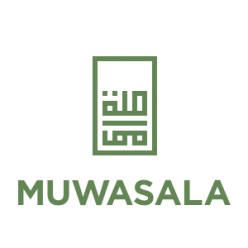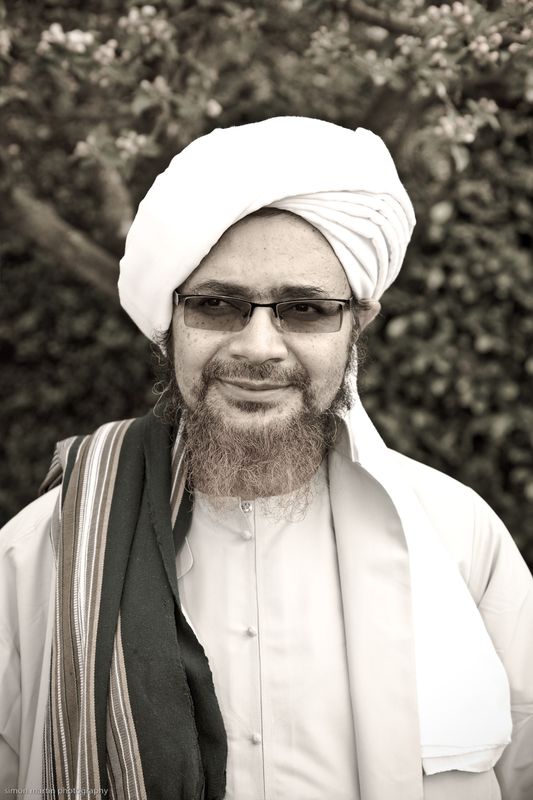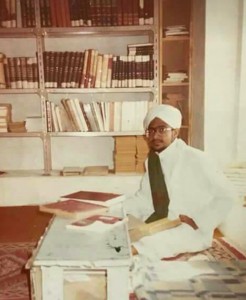His Lineage
Habib Umar is a direct descendant of the Messenger of Allah through Imam al-Husayn. His father and his father’s father and all his forefathers were scholars and knowers of Allah. Among his blessed forefathers are Imam Ali Zayn al-Abidin as well as the first of the Prophetic Household to settle in Hadramawt, Imam Ahmad bin Isa al-Muhajir and his noble descendants, al-Faqih al-Muqaddam Muhammad bin Ali, Shaykh Abd al-Rahman al-Saqqaf and Shaykh Abu Bakr bin Salim. His full lineage is as follows.
He is al-Habib al-‘Allamah Umar bin Muhammad bin Salim bin Hafiz bin ‘Abdullah bin Abu Bakr bin ‘Aydarus bin Umar bin ‘Aydarus bin Umar bin Abu Bakr bin ‘Aydarus bin al-Husayn bin al-Shaykh al-Fakhr Abu Bakr bin Salim bin Abdullah bin Abd al-Rahman bin Abdullah bin Shaykh Abd al-Rahman al-Saqqaf bin Shaykh Muhammad Mawla al-Dawilah, bin Ali Mawla al-Darak, bin ‘Alawi al-Ghayur, bin al-Faqih al-Muqaddam Muhammad, bin Ali, bin Muhammad Sahib Mirbat, bin `Ali Khali’ Qasam, bin ‘Alawi, bin Muhammad Sahib al-Sawma’ah, bin ‘Alawi, bin ‘Ubaydullah, bin al-Imam al-Muhajir il-Allah Ahmad, bin ‘Isa, bin Muhammad al-Naqib, bin Ali al-‘Uraydi, bin Ja’far al-Sadiq, bin Muhammad al-Baqir, bin Ali Zayn al-‘Abidin, bin Husayn al-Sibt, bin Ali bin Abi Talib and Fatimah al-Zahra’, the daughter of our Master Muhammad, the Seal of the Prophets ﷺ.
His Birth
Habib Umar was born in Tarim, in Yemen’s Hadramawt Valley before Fajr on Monday, the 4th Muharram 1383 AH (27th May 1963), and it was there that he grew up. His father, Habib Muhammad, was a great scholar and caller to Allah, and he carefully supervised his son’s upbringing. When he was still very young, his father would take him with him to gatherings of knowledge and on expeditions calling to Allah.
His Study of the Islamic Sciences
At an early age, Habib Umar memorised the Qur’an and began studying the Islamic sciences under his father and many of the great scholars of Tarim of the time. Among them were Habib Muhammad bin ‘Alawi bin Shihab, Habib Ahmad bin Ali Ibn Shaykh Abu Bakr, Habib Abdullah bin Shaykh al-‘Aydarus, Habib Abdullah bin Hasan Balfaqih, Habib Umar bin ‘Alawi al-Kaf, Habib Ahmad bin Hasan al-Haddad, Habib Hasan bin Abdullah al-Shatiri and his brother, Habib Salim, the Mufti, Shaykh Fadl bin Abd al-Rahman Ba Fadl, and Shaykh Tawfiq Aman. He also studied under his older brother, Habib Ali al-Mashhur, the former Mufti of Tarim.
His Migration to al-Bayda’
In 1387 (1967), a socialist government came to power in South Yemen which attempted to eradicate Islam from society. Scholars were persecuted and religious institutions were forcibly closed. In spite of this, Habib Umar’s father, Habib Muhammad, fearlessly continued calling people to Allah. He was required to register with the security forces on a regular basis so that they could check on his whereabouts. Thus, on Friday morning on 29th Dhu’l-Hijjah 1392 (1973) he left Habib Umar, then only nine years of age, in the mosque before the Friday prayer and went to register. He was never seen again. Habib `Umar remained in Tarim under the care of his blessed mother, Hababah Zahra bint Hafiz al-Haddar, and his older brother, Habib Ali al-Mashhur. When the situation in Hadramawt became increasingly difficult, Habib Umar left Tarim in Safar 1402 (1981) just as the Prophet left Makkah when oppression had reached its peak. He intended to travel to the Hijaz to find work and seek knowledge. However, he stopped in the city of al-Bayda’ in North Yemen to visit his father’s great friend and companion on the path, Habib Muhammad al-Haddar. Habib Muhammad insisted that Habib Umar stay in his Ribat1 and study with him and Habib Zayn bin Ibrahim bin Sumayt, the Ribat’s main teacher and this was where Habib Umar remained for the next ten years. Habib Muhammad held him in high regard and could see the future that was awaiting him. He duly married his daughter to him.
Habib Umar inherited his father’s passion for teaching people and calling them to Allah, and he had begun this noble work at the age of fifteen, but it was in al-Bayda that he had the opportunity to work freely. He had a great impact on the youth of the city and was a means for many of them to become students in the Ribat and then scholars and callers to Allah. He established a number of weekly lessons and gatherings of knowledge. He would often travel in order to call to Allah in the area around of al-Bayda’, just as he would travel further afield to al-Hudaydah and Ta’izz. He used to frequently visit Ta’izz in order to take knowledge from the great scholar, Habib Ibrahim bin ‘Aqil bin Yahya.
His Repeated Visits to the Hijaz
During his time in al-Bayda’, Habib Umar made frequent visits to the Hijaz. There he learned from the great Imams of the time: Habib Abd al-Qadir al-Saqqaf, Habib Ahmad Mashhur al-Haddad, and Habib Abu Bakr al-‘Attas al-Habashi. He took license to narrate from the chains of transmission in Hadith and in other sciences from Shaykh Muhammad Yasin al-Faddani and the Hadith scholar of the Two Sanctuaries, Sayyid Muhammad bin ‘Alawi al-Maliki, as well as other scholars.
His Move to Oman and al-Shihr
After the fall of the socialist regime in 1410 (1990) and the unification of North and South Yemen, Habib Umar returned to Hadramawt. He visited Tarim, and then settled with some of his students in the city of Salalah in the Sultanate of Oman. For a year and a half he called people to Allah in the region and then in 1413 (1992) he moved to the city of al-Shihr, which lies on the Indian Ocean in the province of Hadramawt. The Ribat of al-Mustafa had recently been reopened after closure during the days of the socialist regime. Habib Umar began teaching in the Ribat and reviving its traditions. Many students from different regions of Yemen and parts of South-East Asia came to seek knowledge from him.
His Return to Tarim
Habib Umar then returned to his home city and immediately began to breathe new life into the religious life of the region. His tireless work led to the establishment of Dar al-Mustafa in 1414 (1994). Dar al-Mustafa is a centre for traditional Islamic learning based upon three foundations: the first is `ilm (knowledge), learning the sciences of the Sacred Law from those who are qualified to impart them through connected chains of transmission; the second is tazkiyah, purifying the soul and refining one’s character and the third is da`wah, calling to Allah and conveying beneficial knowledge. Dar al-Mustafa began in Habib Umar’s house next to the Mawla ‘Aydid mosque and a batch of students from South East Asia came to study with him, as well as students from Tarim and other parts of Yemen. As the number of students increased, the need for a purpose-built building became clear. Land was duly purchased and building started. Dar al-Mustafa was officially opened in 1417 (1997). Habib Umar honoured his father’s sacrifice by making the opening date 29th Dhu’l-Hijjah, the day on which Habib Muhammad was abducted. Although Dar al-Mustafa was established recently, it is intimately connected to the illustrious legacy of the scholarly tradition of Hadramawt, which stretches back more than a thousand years. In this we witness the renewal of the religion (tajdid) that is taking place at the hands of Habib Umar.
Dar al-Zahra’ was opened in 1422 (2001) to provide learning opportunities for women as well. A number of branches of Dar al-Mustafa have since been opened in Hadramawt and South East Asia. A branch was opened in the Yemeni capital, Sanaa and older ribats have also been revived, such as the ribats of al-Shihr, Mukalla’ and ‘Aynat. Dar al-Mustafa and its branches continue to grow and receive students from all corners of the earth.
His Travels
Habib Umar constantly travels to convey the Prophetic message and to call people to Allah. He delivers regular lectures and khutbahs within Hadramawt and often makes trips abroad. His travels have taken him to almost all the Arab states, East and South Africa, South East Asia and Australia, the Indian Subcontinent, Western Europe and Scandinavia and North America. He has connected to the chains of transmission of the scholars of these regions and has also participated in many conferences.
His Publications
Although Habib Umar is best known for his speeches and lessons, he has authored several works. Among them are al-Dhakirah al-Musharrafah,2 which contains personally obligatory knowledge for every Muslim, and three short hadith compilations, Mukhtar al-Hadith, Nur al-Iman and Qutuf al-Falihin. His Qabas al-Nur al-Mubin is a summarised version of the third quarter of Imam al-Ghazali’s Ihya’ Ulum al-Din and is an expression of his concern for curing the ailments of the heart. It also reflects the love and respect that the Ba ‘Alawi scholars have traditionally had for Ihya’ ‘Ulum al-Din. A selection of Habib Umar’s speeches and wisdom have been collected in Tawjihat al-Tullab and Tawjih al-Nabih, and some of his khutbahs have been collected in Fayd al-Imdad. Khulasat al-Madad al-Nabawi is Habib Umar’s compilation of adhkar for the seeker to recite on a daily basis. It contains Prophetic invocations and the litanies of many of the great Imams. His mawlid compositions, al-Diya’ al-Lami’ and al-Sharab al-Tahur are recited in gatherings throughout the world, as are his poems.
His Students
Habib Umar’s students can be found throughout the world calling people to Allah. Many have opened their own institutions. Habib Ali al-Jifri has made numerous expeditions around the world and established the Tabah Foundation in Abu Dhabi. Habib Kazim al-Saqqaf, Habib Muhammad Abd al-Rahman al-Saqqaf and Habib Husayn al-Saqqaf are well known for their efforts calling people to Allah. Shaykh Umar Husayn al-Khatib, through his teaching role in Dar al-Mustafa and through his travels, has benefited countless people. Habib `Umar’s students have also had a big impact in South East Asia. This is reflected by the thousands of people that attended the gatherings of the late Habib Mundhir al-Musawa (may Allah have mercy on him) in Jakarta. Habib Umar’s students are also benefiting communities in the West, Australia and East and South Africa.
Projects He Supports
Habib Umar lends his support to numerous religious and social projects throughout the world. He established al-Ra’fah Foundation in 1418 (1998), which sponsors students of sacred knowledge, teachers, orphans and widows and assists the poor and needy in the Hadramawt region. When severe floods struck Hadramawt in 2008, al-Ra’fah played a key role in relieving the suffering of those who lost their homes and property. Al-Ra’fah continues to support those suffering the effects of conflict in Yemen.
Habib Umar joined with the world’s leading Muslim scholars to sign ‘A Common Word,’ a document that aims to build bridges between Muslims and Christians. In 2008 he attended the ‘Common Word’ conference chaired by the Archbishop of Canterbury at Cambridge University, and delivered a speech on the need to facilitate inter-faith dialogue. He is currently promoting the use of permaculture to revive agriculture in Hadramawt and elsewhere.
His Attributes
Only a knower of Allah can truly describe another knower of Allah. That said, anyone that spends time in the company of Habib Umar will witness his complete emulation of his grandfather, the Messenger of Allah ﷺ and also his emulation of his predecessors among the Ba ‘Alawi Imams. Whether it be in his acts of worship, in his dealings with people, in receiving his guests, in the words that he speaks, or in his smile, his every action is an expression of his Prophetic inheritance. He shows utmost mercy to every creature and desires goodness and elevation for every human being. He invites non-Muslims to accept Islam, calls Muslims to increase in faith and to benefit others and assists spiritual seekers on the path to Allah. His concern above all is the Ummah of our Master Muhammad ﷺ and playing his part in the renewal of Islam.
May he be blessed with the highest level of the pleasure of Allah and His Messenger ﷺ. May Allah bestow His enabling grace upon him in all of his affairs and benefit us immensely by him in this life and the next.
—
1 A ribat is a religious school
2 Translated under the title “The Glorious Treasure” by Mohammad Ahmad Mbaye
First image courtesy of Simon Martin Photography


